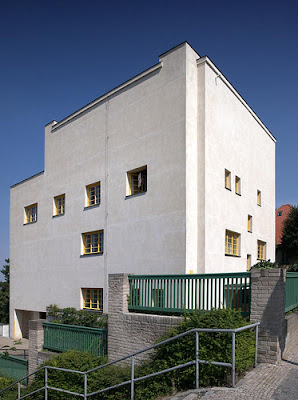 |
| The Müller House, Prague |
After writing about how British design promoters were shy of ornamentation in the 1930s, I thought I ought to go to the ur-text, Adolf Loos’s essay Ornament and Crime (1908). Influential designers and architects are bound to be opinionated but I hadn’t realised quite how opinionated Loos was. The essay was a response to the critics of his landmark Vienna building for Goldman and Salatsch in the Michaelerplatz, designed as one in the eye for the Secession.
Loos said that ornamentation belonged to an earlier stage in cultural evolution and that using it in the 20th century was no longer appropriate. But he said it more forcefully:
"The Papuan tattoos his skin, his boat, his oar, in short, everything that is within his reach. He is no criminal. The modern man who tattoos himself is a criminal and a degenerate. Those who are tattooed but are not imprisoned are latent criminals or degenerate aristocrats. If a tattooed person dies at liberty, it is only that he died a few years before he committed a murder."
“The evolution of culture,” he said, “is synonymous with the removal of ornament from objects of daily use.”
Ornament was wasteful because decorated items soon bored their users, who replaced them before they needed to, and it impoverished the worker because he was not adequately compensated. Ornament “represents a crime against the national economy, and, as a result of it, human labour, men and material are ruined.”
But Loos’s buildings don’t meet the expectations created by Ornament and Crime. They are lavishly finished. In the Müller House in Prague (1928-30) there were few white walls, as there were in some of Voysey's Arts and Crafts houses, which are puritanical by comparison. Surfaces were painted dark green, grey-green, brick red, navy blue and yellow, veneered in mahogany and maple or constructed of travertine and Cippolino marble.
 |
| The living room, Müller House |
Loos specified decorations, light fittings, furnishing and pictures. In the living room there is a simple brick and marble fireplace but patterned carpets. He chose Chippendale chairs for the dining room, which has a coffered mahogany ceiling. The Library is also furnished in mahogany, with deep-buttoned Chesterfield sofas and a Dutch tiled stove.
 |
| The library, Müller House |

No comments :
Post a Comment